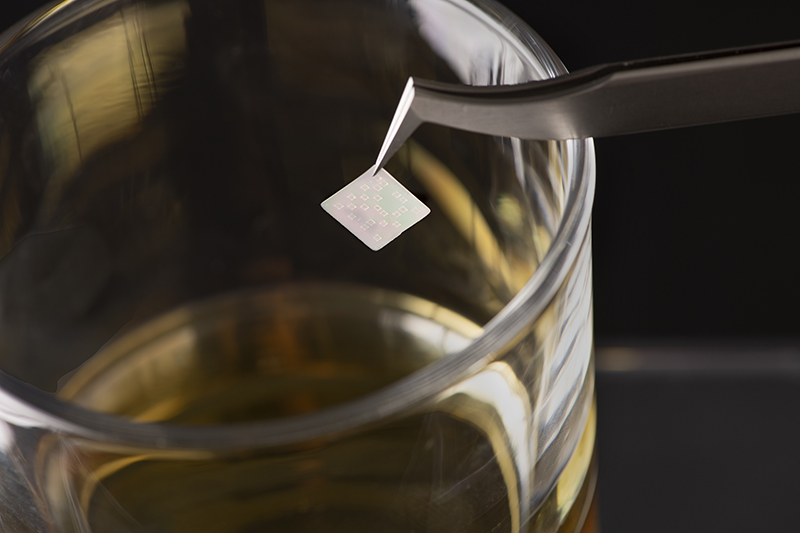June 6, 2022
An edible QR code takes a shot at fake whiskey

The days of fake whiskey could be numbered, thanks to a team of biomedical engineers from Purdue University and South Korea. The team, led by Young Kim, associate head for research and an associate professor in Purdue’s Weldon School of Biomedical Engineering, has developed an QR code on an edible silk tag that manufacturers can place in bottles of whiskey. Consumers can use a smartphone app to confirm the whiskey’s authenticity. (Purdue University photo/John Underwood)
WEST LAFAYETTE, Ind. — In the future, when you order a shot of whiskey, you might ask the bartender to hold an edible fluorescent silk tag that could be found floating inside – even though it is safe to consume.
This little silk tag with a QR code is a security measure that could reveal if the whiskey you’re wanting to buy is fake. Simply using a smartphone to scan the tag, which was developed by biomedical engineers from Purdue University and the National Institute of Agricultural Sciences in South Korea, could confirm the drink’s authenticity.
There are, of course, no tags currently placed in bottles of whiskey. But this new anticounterfeiting technology, published in the journal ACS Central Science, could be a step toward not only finding a solution for the alcohol industry but also addressing fake medications.
 Jungwoo Leem, a postdoctoral research associate, and Young Kim, both of Purdue’s Weldon School of Biomedical Engineering, are part of a global research team that has developed an edible QR code on a tag made of specialized silk which could help consumers detect fake whiskey. (Purdue University photo/John Underwood)
Download image
Jungwoo Leem, a postdoctoral research associate, and Young Kim, both of Purdue’s Weldon School of Biomedical Engineering, are part of a global research team that has developed an edible QR code on a tag made of specialized silk which could help consumers detect fake whiskey. (Purdue University photo/John Underwood)
Download image
“Some liquid medicines contain alcohol. We wanted to test this first in whiskey because of whiskey’s higher alcohol content,” said Young Kim, associate head for research and an associate professor in Purdue’s Weldon School of Biomedical Engineering. “Researchers apply alcohol to silk proteins to make them more durable. Because they tolerate alcohol, the shape of the tag can be maintained for a long time.”
Kim has worked on anticounterfeit measures ranging from cyberphysical watermarks to tags made of fluorescent silk proteins. The tags have a code that a consumer or patient can activate with a smartphone to confirm authenticity of a product.
The code on the fluorescent silk tag is the equivalent of a barcode or QR code and is not visible to the naked eye. The tags are also edible, causing no issues if a person swallowed it while downing a shot of whiskey. The tags have not affected the taste of the whiskey.
Kim and Jungwoo Leem, a postdoctoral research associate, said making the tags involves processing fluorescent silk cocoons from specialized silkworms to create a biopolymer, which can be formed into a variety of patterns to encode the information. You can watch a video demonstration of the tag by Kim and Leem.
“Alcohol spirts are vulnerable to counterfeiting. There are a lot of fake whiskeys being sold,” said Leem, referencing other studies mentioned in the journal article about the economic cost and loss of purchasing fake alcoholic spirits, including how 18% of adults in the United Kingdom experienced purchasing counterfeit alcoholic spirits.
“Counterfeit items, such as medicines and alcohol, are big issues around the world. There are numerous examples of large amounts of fake medications sold throughout the world, which, in some instances, kill people,” said Kim.
“Online pharmacies sell controlled substances to teens. People can buy counterfeit opioids easily. This work is extremely important for patients and buyers in addressing this issue,” Kim said. “If you have this technology on or in your medicines, you can use your smartphone to authenticate. We want to empower patients to be aware of this issue. We want to work with pharmaceutical companies and alcohol producers to help them address this issue.”
Kim and Leem placed tags in various brands and price points of whiskey (80 proof, 40% alcohol per volume) over a 10-month period and were able to continually activate the tags and codes with a smartphone app.
One of the ways of bringing this issue to light is to literally shine a light on the tags. The team developed ways and methods for the tags to be activated by smartphones in a variety of light settings.
Kim said the tags are an additional authentication mechanism for marked safety seals on bottles or pills and could help by being placed in high-dollar bottles of alcohol or on expensive medications individually.
In addition to Kim and Leem, members of the research team were Hee-Jae Jeon, Yuhyun Ji and Sang Mok Park from Purdue’s Weldon School of Biomedical Engineering; Yunsang Kwak from the Department of Mechanical System Engineering at Kumoh National Institute of Technology in South Korea; and Jongwoo Park, Kee-Young Kim and Seong-Wan Kim from the Department of Agricultural Biology at the National Institute of Agricultural Sciences in South Korea. Funding came from the Cooperative Research Program for Agriculture Science and Technology Development (PJ015364) from the Rural Development Administration of the Republic of Korea, the U.S. Air Force Office of Scientific Research (FA2386-17-1-4072), the NIH Technology Accelerator Challenge from the National Institutes of Health, and the Trask Innovation Fund from Purdue University. The technology was disclosed to the Purdue Research Foundation Office of Technology Commercialization. For information on licensing opportunities, contact Patrick Finnerty of OTC at pwfinnerty@prf.org about 2022-KIM-69670.
Kim’s work at Weldon School of Biomedical Engineering is just one of many life-changing projects conducted by the biomedical engineering faculty and students. Many of those projects are partnerships among Weldon, health care providers, medical researchers and medical device companies that are key in taking aspects from classes and research labs into clinical settings.
About Purdue University
Purdue University is a top public research institution developing practical solutions to today’s toughest challenges. Ranked in each of the last four years as one of the 10 Most Innovative universities in the United States by U.S. News & World Report, Purdue delivers world-changing research and out-of-this-world discovery. Committed to hands-on and online, real-world learning, Purdue offers a transformative education to all. Committed to affordability and accessibility, Purdue has frozen tuition and most fees at 2012-13 levels, enabling more students than ever to graduate debt-free. See how Purdue never stops in the persistent pursuit of the next giant leap at https://stories.purdue.edu
Writer, Media contact: Matthew Oates, 765-586-7496 (cell), oatesw@purdue.edu, @mo_oates
Sources: Young Kim, youngkim@purdue.edu
Jungwoo Leem, leem0@purdue.edu
ABSTRACT
Edible Matrix Code with Photogenic Silk Proteins
Jung Woo Leem, Hee-Jae Jeon, Yuhyun Ji, Sang Mok Park, Yunsang Kwak, Jongwoo Park, Kee-Young Kim, Seong-Wan Kim, and Young L. Kim
https://doi.org/10.1021/acscentsci.1c01233
Counterfeit medicines are a healthcare security problem, posing not only a direct threat to patient safety and public health but also causing heavy economic losses. Current anticounterfeiting methods are limited due to the toxicity of the constituent materials and the focus of secondary packaging level protections. We introduce an edible, imperceptible, and scalable matrix code of information representation and data storage for pharmaceutical products. This matrix code is digestible as it is composed of silk fibroin genetically encoded with fluorescent proteins produced by ecofriendly, sustainable silkworm farming. Three distinct fluorescence emission colors are incorporated into a multidimensional parameter space with a variable encoding capacity in a format of matrix arrays. This code is smartphone-readable to extract a digitized security key augmented by a deep neural network for overcoming fabrication imperfections and a cryptographic hash function for enhanced security. The biocompatibility, photostability, thermal stability, long-term reliability, and low bit error ratio of the code support the immediate feasibility for dosage-level anticounterfeit measures and authentication features. The edible code affixed to each medicine can serve as serialization, track and trace, and authentication at the dosage level, empowering every patient to play a role in combating illicit pharmaceuticals.
Note to journalists: B-roll, interview soundbites and images of Young Kim are available via Google Drive. For a copy of the research paper, please contact Matthew Oates at oatesw@purdue.edu.

